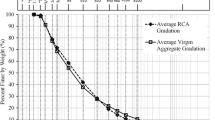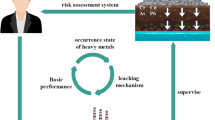Abstract
Leaching of metals (calcium (Ca), chromium (Cr), copper, (Cu), iron (Fe), and zinc (Zn)) of recycled concrete aggregates (RCAs) were investigated with four different leachate extraction methods (batch water leach tests (WLTs), toxicity leaching procedure test (TCLP), synthetic precipitation leaching procedure test (SPLP), and pH-dependent leach tests). WLTs were also used to perform a parametric study to evaluate factors including (i) effects of reaction time, (ii) atmosphere, (iii) liquid-to-solid (L/S) ratio, and (iv) particle size of RCA. The results from WLTs showed that reaction time and exposure to atmosphere had impact on leaching behavior of metals. An increase in L/S ratio decreased the effluent pH and all metal concentrations. Particle size of the RCA had impact on some metals but not all. Comparison of the leached concentrations of metals from select RCA samples with WLT method to leached concentrations from TCLP and SPLP methods revealed significant differences. For the same RCA samples, the highest metal concentrations were obtained with TCLP method, followed by WLT and SPLP methods. However, in all tests, the concentrations of all four (Cr, Cu, Fe, and Zn) metals were below the regulatory limits determined by EPA MCLs in all tests with few exceptions. pH-dependent batch water leach tests revealed that leaching pattern for Ca is more cationic whereas for other metals showed more amphoteric. The results obtained from the pH-dependent tests were evaluated with geochemical modeling (MINTEQA2) to estimate the governing leaching mechanisms for different metals. The results indicated that the releases of the elements were solubility-controlled except Cr.










Similar content being viewed by others
References
Allison JD, Brown DS, Novo-Gradac KJ (1991) MINTEQA2/PRODEFA2 a geochemical assessment model for environmental systems: version 3.0 user’s manual. U.S. Environmental Protection Agency, Washington, D. C, EPA/600/3-91/021
Apul DS, Gardner KH, Eighmy TT, Fallman A-M, Comans RNJ (2005) Simultaneous application of dissolution/precipitation and surface complexation/surface precipitation modeling to contaminant leaching. Environ Sci Technol 39(15):5736–5741
Astrup T, Dijkstra JJ, Comans RNJ, Van der Sloot HA, Christensen TH (2006) Geochemical modeling of leaching from MSWI air-pollution-control residues. Environ Sci Technol 40(11):3551–3557
Baur I, Keller P, Mavrocordatos D, Wehrli B, Johnson CA (2004) Dissolution-precipitation behaviour of ettringite, monosulfate, and calcium silicate hydrate. Cem Concr Res 34(2):341–348
Black CJ, Brockway D, Hodges S, Milner A et al (1992) Utilisation of Latrobe Valley brown coal fly ash. In: Barton CM (ed) Proc. energy, economics & environment-gipssland basin symp. AusIMM, Melbourne, pp 149–155
Bullard JW, Jennings HM, Livingston RA, Nonat A, Scherer GW, Schweitzer JS, Scrivener KL, Thomas JJ (2011) Mechanisms of cement hydration. Cem Concr Res 41(12):1208–1223
Cetin B, Aydilek AH (2013) pH and fly ash type effect on trace metal leaching from embankment soils. Resour Conserv Recycl 80:107–117
Cetin B, Aydilek AH, Guney Y (2010) Stabilization of recycled base materials with high carbon fly ash. Resour Conserv Recycl 54:879–892
Cetin B, Aydilek AH, Li L (2012a) Experimental and numerical analysis of metal leaching from fly ash-amended highway bases. Waste Manag 32(5):965–978
Cetin B, Aydilek AH, Guney Y (2012b) Leaching of trace metals from high carbon fly ash stabilized highway base layers. Resour Conserv Recycl 58:8–17
Cetin B, Aydilek AH, Li L (2014) Trace metal leaching from embankment soils amended with high-carbon fly ash. Journal of Geotechnical and Geoenvironmental Engineering-ASCE 140(1):1–13
Chen J, Bradshaw S, Benson CH, Tinjum JM, Edil TB (2012) pH-dependent leaching of trace elements from recycled concrete aggregate. In: Hryciw RD, Athanasopoulos-Zekkos A, Yesiller N (eds) Geocongress 2012. American Society of Civil Engineers, Oakland, pp 3729–3738
Chen J, Tinjum JM, Edil TB (2013) Leaching of alkaline substances and heavy metals from recycled concrete aggregate used as unbound base course. Transp Res Rec 2349:81–90
Cornelis G, Johnson CA, Gerven TV, Vandecasteele C (2008) Leaching mechanisms of oxyanionic metalloid and metal species in alkaline solid wastes: a review. Appl Geochem 23(5):955–976
Daniels JL, Das G (2014) Practical leachability and sorption considerations for ash management. Proceedings of Geocongress, Atlanta, GA, 14p
Dijkstra JJ, Van der Sloot HA, Comans RNJ (2002) Process identification and model development of contaminant transport in MSWI bottom ash. Waste Manag 22(5):531–1
Dijkstra JJ, Meeussen JCL, Comans RNJ (2004) Leaching of heavy metals from contaminated soils: an experimental and modeling study. Environ Sci Technol 38(16):4390–4395
Edil TB (2012) Recycled unbound materials. Minnesota Department of Transportation, St. Paul, Report No. 2012–35
Engelsen CJ, van der Sloot HA, Wibetoe G, Petkovic G, Stoltenberg-Hansson E, Lund W (2009) Release of major elements from recycled concrete aggregates and geochemical modelling. Cem Concr Res 39(5):446–459
Engelsen CJ, van der Sloot HA, Wibetoe G, Justnes H, Lund W, Stoltenberg-Hansson E (2010) Leaching characterisation and geochemical modelling of minor and trace elements released from recycled concrete aggregates. Cem Concr Res 40(12):1639–1649
Engelsen CJ, Wibetoe G, van der Sloot HAH, Lund W, Petkovic G (2012) Field site leaching from recycled concrete aggregates applied as sub-base materials in road construction. Sci Total Environ 427–428:86–97
EPA (2009). Water Drinking Limits. < http://water.epa.gov/drink/contaminants/>. Accessed 14 March 2016
Fruchter JS, Ral D, Zachara JM (1990) Identification of solubility-controlling solid phases in a large fly ash field lysimeter. Environ Sci Technol 24(8):1173–1179
Garavaglia R, Caramuscio P (1994) Coal fly-ash leaching behaviour and solubility controlling solids. Stud Environ Sci 60:87–2
Garrabrants AC, Sanchez F, Kosson DS (2004) Changes in constituent equilibrium leaching and pore water characteristics of a Portland cement mortar as a result of carbonation. Waste Manag 24(1):19–36
Gervais C, Garrabrants AC, Sanchez F, Barna R, Moszkowicz P, Kosson DS (2004) The effects of carbonation and drying during intermittent leaching on the release of inorganic constituents from a cement-based matrix. Cem Concr Res 34(1):119–131
Gitari WM, Petrik LF, Etchebers O, Key DL, Okujeni C (2008) Utilization of fly ash for treatment of coal mines wastewater: solubility controls on major inorganic contaminants. Fuel 87(12):2450–2462
Gitari WM, Fatoba OO, Petrik LF, Vadapalli WRK (2009) Leaching characteristics of selected South African fly ashes: effect of pH on the release of major and trace species. J Environ Sci Health A 44:206
Gougar MLD, Scheetz BE, Roy DM (1996) Ettringite and C-S-H Portland cement phases for waste immobilization: a review. Waste Manag 16(4):295–303
Iyer RS, Stanmore BR, Pullammanappallil PC (1999) Solid–liquid mass transfer during leaching of calcium from dilute slurries of flyash. Chemical engineering research and design. Trans Inst Chem Eng Part A 77(8):764
Johnson CA, Kaeppeli M, Brandenberger S, Ulrich A, Bauman W (1999) Hydrological and geochemical factors affecting leachate composition in municipal solid waste incinerator bottom ash part II. The geochemistry of leachate from Landfill Lostorf, Switzerland. J Contam Hydrol 40:239–259
Karamalidis AK, Vouidrias EA (2008) Anion leaching from refinery oily sludge and ash from incineration of oily sludge stabilized/solidified with cement. Part II. Modeling. Environ Sci Technol 42:6124–6130
Kim AG, Hesbach P (2009) Comparison of fly ash leaching methods. Fuel 88:926–937
Komonweeraket K, Cetin B, Aydilek AH, Benson CH, Edil TB (2015a) Effects of pH on the leaching mechanisms of elements from fly ash mixed soils. Fuel 140:788–802
Komonweeraket K, Cetin B, Benson CH, Aydilek AH, Edil TB (2015b) Leaching characteristics of toxic constituents from coal fly ash mixed soils under the influence of pH. Waste Manag 38:174–184
Komonweeraket K, Cetin B, Aydilek AH, Benson CH, Edil TB (2015c) Geochemical analysis of leached elements from fly ash stabilized soil. J Geotech Geoenviron Eng ASCE. doi:10.1061/(ASCE)GT.1943-5606.0001288, 04015012
Kosson DS, van der Sloot HA, Eighmy TT (1996) An approach for estimation of contaminant release during utilization and disposal of municipal waste combustion residues. J Hazard Mater 47(1–3):43–45
Kosson DS, van der Sloot H, Sanchez F, Garrabrants AC (2002) An integrated framework for evaluating leaching in waste management and utilization of secondary materials. Environ Eng Sci 19(3):159–204
Lange LC, Hills CD, Poole AB (1996) The effect of accelerated carbonation on the properties of cement-solidified waste forms. Waste Manag 16(8):757–763
Langmuir D (1997) Aqueous environmental geochemistry. Prentice-Hall, Inc., New Jersey
Li L, Benson CH, Edil TB, Hatipoglu B (2006) Groundwater impact from coal ash in highways. Waste Resour Manag 159(4):151–162
Li L, Benson CH, Edil TB (2009) Mechanical performance of pavement geomaterials stabilized with fly ash in field applications. Coal Combust Gasification Prod 1:43–49
Mamlouk MS, Zaniewski JP (2011) Materials for civil and construction engineers. Prentice Hall, Upper Saddle River
McBride MB (1994) Environmental chemistry of soils. Oxford University Press, New York
Mudd GM, Weaver TR, Kodikara J (2004) Environmental geochemistry of leachate from leached brown coal ash. J Environ Eng ASCE 130(12):1514–1516
Mulugeta M, Engelsen CJ, Wibetoe G, Lund W (2011) Charge-based fractionation of oxyanion-forming metals and metalloids leached from recycled concrete aggregates of different degrees of carbonation: a comparison of laboratory and field leaching tests. Waste Manag 31(2):253–258
Murarka IP, Rai D, Ainsworth CC (1992) Geochemical basis for predicting leaching of inorganic constituents from coal-combustion residues. Waste testing and quality assurance symposium, Washington, DC, pp 279–8
Pandey B, Kinrade SD, Catalan LJ (2012) Effects of carbonation on the leachability and compressive strength of cement-solidified and geopolymer-solidified synthetic metal wastes. J Environ Manag 101:59–67
Poon CS, Qiao XC, Chan D (2006) The cause and influence of self-cementing properties of fine recycled concrete aggregates on the properties of unbound sub-base. Waste Manag 26(10):1166–1172
Sanchez F, Langley White MK, Hoang A (2009) Leaching from granular cement-based materials during infiltration/wetting coupled with freezing and thawing. J Environ Manag 90(2):983–993
SDDOT (2004) 2004 standard specifications for highway granular bases and surfacing. < http://www.sddot.com/business/contractors/Specs/default.aspx>. (1 Jan 2016)
Stumm W, Morgan JJ (1996) Aquatic chemistry: chemical equilibria and rates in natural waters. Wiley, New York
Tanyu BF, Edil TB, Benson CH, Kim WH (2005) Development of methodology to include structural contribution of alternative working platforms in pavement structure. J Transp Res Rec 1936:70–77
Tutumluer E, Pan T (2008) Aggregate morphology affecting strength and permanent deformation behavior of unbound aggregate materials. J Mater Civ Eng 20(9):617–627
van der Sloot HA, Dijkstra JJ (2004) Development of horizontally standardized leaching tests for construction materials: a material based or release based approach? ECN-C--04-060, Dutch Ministry of Housing, Spatial Planning and the Environment
Van Gerven T, Cornelis G, Vandoren E, Vandecasteele C (2007) Effects of carbonation and leaching on porosity in cement-bound waste. Waste Manag 27(7):977–985
Ward CR, French D, Jankowski J, Dubikova M, Li Z, Riley KW (2009) Element mobility from fresh and long-stored acidic fly ashes associated with an Australian power station. Int J Coal Geol 80:224–236
Acknowledgments
Recycled concrete materials were provided by the South Dakota Department of Transportation (SDDOT). Endorsement by SDDOT is not implied and should not be assumed.
Author information
Authors and Affiliations
Corresponding author
Additional information
Responsible editor: Philippe Garrigues
Rights and permissions
About this article
Cite this article
Bestgen, J.O., Cetin, B. & Tanyu, B.F. Effects of extraction methods and factors on leaching of metals from recycled concrete aggregates. Environ Sci Pollut Res 23, 12983–13002 (2016). https://doi.org/10.1007/s11356-016-6456-0
Received:
Accepted:
Published:
Issue Date:
DOI: https://doi.org/10.1007/s11356-016-6456-0




